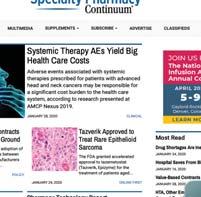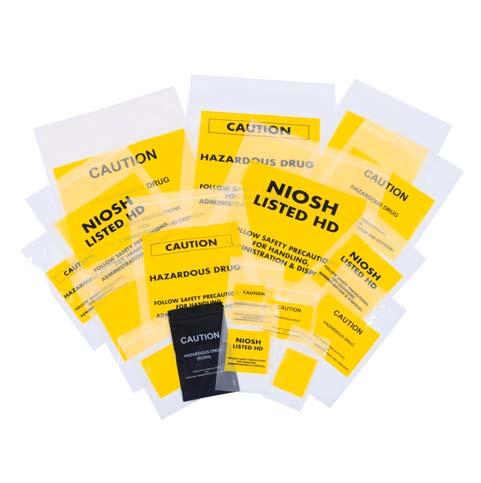
14 minute read
Erin Fox’s tips for drug formularies and price spikes
5 Strategies for Controlling Drug Formulary Costs
Monitoring FDA approvals, forecasting potential price spikes and having good team communication are activities that hospital pharmacists can do to manage high-cost drugs in their formularies, an expert said during the American College of Clinical Pharmacy (ACCP) 2020 virtual annual meeting.
Few laws address drug prices, said Erin R. Fox, PharmD, the senior director of drug information and support ‘Use the same strategies that you use to manage a shortage to manage a price spike, because at the end of the day, you’re just going to need to use less so that you can still afford that product.’ —Erin R. Fox, PharmD
services at the University of y of f Utah Health, in Salt Lake City. ty. And there’s not much help p from the various regulatory agencies that have some oversight over therapeutics. For example, Medicare, the he h largest payor, is forbidden from negotiating prices. The Federal Trade Commission has some influence e on pricing, but it focuses its its pricing efforts primarily around around the narrow area of antitrust laws and “pay-to-delay” deals in which brandname and generic drug companies pay others to delay the introduction of cheaper alternatives. The FDA cannot consider drug pricing in its approval decisions. However, its approvals have indirect results on pricing, whether it is for me-too drugs, orphan drugs or those with slight changes in formulation that extend patents.
As for the states, although they often have price gouging laws, those typically apply to price hikes of items such as gas, not medications.
Focus on the Patient
When managing your formulary, Fox said, beyond considering a drug’s efficacy and therapeutic use, think about its intended patient population. If it’s a targeted treatment or product that will be used in a small number of patients, budgeting it may be very difficult. In an inpatient setting, “even one to two patients can really knock your budget out of whack,” she said. Also bear in mind any administration and monitoring challenges brought by products, including what setting is most appropriate. In many cases, new specialty products are for chronic illnesses; because they are not given on a daily basis, they could wait until a patient is in the outpatient setting, which shifts the costs to a different site of care. Finally, don’t forget about Risk Evaluation and Mitigation Strategy (REMS) requirements; you may need to develop specific procedures for how your organization will handle REMS.
In addition, Fox said, try to prepare for potential spikes in drug prices. There are a number of risk factors to watch. One important consideration is whether the drug is subject to the Unapproved Drugs Initiative, which the FDA created in 2006 to reduce the number of “grandfathered” drugs on the market that didn’t go through a formal FDA approval process. (Before 1938, drugs weren’t required by law to be approved by the FDA.) The initiative offered manufacturers market exclusivity for drugs they took through the regulatory process, but
that inducement had an unintended consequence: It allowed drugmakers to raise prices with virtually no competition.
Two cases in point: vasopressin and epinephrine, which saw price increases after FDA approval ranging from 75% to 471%, Fox said. This may now change; on Nov. 20, the Department of Health and Human Services announced it was terminating the program. Still, drugs produced by a sole manufacturer or for a small market also may see some opportunistic pricing, so Fox said it’s important to keep an eye on the number of players in a given market segment. Drug shortages, too, can result in price increases due to manufacturing costs, raw materials changes or company mergers, she noted.
Fox cited five additional steps pharmacists can take to prepare for the impact of new drugs on a hospital’s formulary: 1 Monitor and track new drug approvals. It’s worth the time to devote resources to tracking FDA approvals of new drugs for several reasons, not the least of which is to start estimating how much those new approvals will cost, and how much of a dent in your drug budget they may cause. 2 Flag a page in your drug shortages handbook. “It’s really nice when you can pull out your drug shortage tool kit,” Fox said. “Use the same strategies that you use to manage a shortage to manage a price spike, because at the end of the day, you’re just going to need to use less so that you can still afford that product.” Finding new uses for older, less expensive drugs also can help, she said. 3 Share what you’ve found. Proactive information on the effects of newly approved and/or launched medications is too precious to keep to yourself, Fox stressed. To that end, be sure to create systems that not only help you make quick therapeutic and operational assessments of new products, but also to effectively communicate those strategies and findings to your stakeholders. 4 Keep an eye on drug utilization. It’s worth setting up some type of surveillance of drug usage at your own institution, even if it’s informal, to try to catch some increased use of older drugs, Fox noted. COVID-19 has presented a wild card, in that everything is off-label. Vet drug usage through your infectious disease clinicians. 5 Confer with the experts. Finally, Fox said, make friends with your specialty clinicians, and learn what they’re hearing about at meetings. “You can sometimes get a heads-up on something based on the latest abstract that you may not have caught under your normal surveillance,” she said.

Talking and collaborating with others to find creative solutions to manage high-cost drugs in the formulary are key, commented Steven T. Johnson, PharmD, the session moderator and vice president of clinical services for Comprehensive Pharmacy Services.
“Everybody has a stake,” Johnson said, noting that average annual health care costs are rising at a pace exceeding the gross domestic product. “We have to work together, and we really have to do it now. It’s looking at every possible avenue to drop the cost of health care so that we all can afford quality health care and ensure equitable access to care, whether it’s ensuring appropriate use for a hyperinflationary drug or eliminating access if it’s truly not providing value for the class.”
For additional resources, Johnson suggested ACCP’s Drug Information Practice and Research Network, which has a paper on formulary management challenges and opportunities (J Am Coll Clin Pharm 22 Sep 2020. https://doi. org/10.1002/jac5.1332). —Karen Blum
The sources reported no relevant fi nancial disclosures.







Read Specialty Pharmacy Continuum Anywhere, Anytime!








2021 Payment Rules Affecting Pharmacy
As we move into the new outpatient/ambulatory payment year Table. Antibody Infusion Codes still in the midst of the COVID-19 pandemic, navigating payment rules across sites of care and ensuring that phar- Product HCPCS Long Descriptor Short Descriptor macy is in sync with their organiza- Regeneron’s anti- Q0243 Injection, casirivimab and casirivimab tion’s overall strategies are essential. body casirivimab and imdevimab imdevimab, 2400 mg and imdevimab Themes finalized in the rule sets are: (REGN-COV2) embrace patient centricity, continue M0243 Intravenous infusion, casirivimab casirivi to simplify (electronic health record requirements and reporting, regulaand imdevimab includes infusion and post-administration monitoring and imdevi infusion tions), cut costs and save money, and
0
0 0C 0
20 0C
“Reimbursement Matters” is a tool for maintaining your health system’s fiscal health. Please email the author at bonniekirschenbaum@ gmail.com with suggestions on reimbursement issues that you would like to see covered. Bonnie Kirschenbaum, MS, FASHP, FCSHP
not lose focus on pharmacy’s efforts to combat the opioid crisis.

2021 OPPS Effects
Our September issue (bit.ly/3rW3VQt) summarized the proposed Outpatient Prospective Payment System (OPPS) rules. The components of the rules most affecting pharmacy include: 1. Focus on site of care. Site-neutral payments remain in place. 2. Patient centricity. Continue to give beneficiaries more affordable choices on where to obtain care with the potential for lower out-of-pocket expenses, including those for surgeries. The inpatient-only list is phasing out within three years, beginning with 300 musculoskeletal-related services in 2021 and loosened restrictions for physician-owned hospitals. Criteria for adding surgical procedures to the ambulatory surgery center covered procedures list changed with 267 new ones.
3. Price transparency of hospital
standard charges. Without changes from the proposed rules, transparency is required Jan. 1, 2021. 4. Prior authorization. Beginning July 1, 2021, the Centers for Medicare & Medicaid Services (CMS) is implementing a prior authorization process for cervical fusion with disk removal and implanted spinal neurostimulators in hospital outpatient departments. The current requirements for five categories of services, including the use of botulinum toxin injections, continues.
5. Payment rates for Medicare Part
B drugs. For a summary, see the table in the expanded version of this article on pharmacypracticenews.com.
These OPPS changes apply only to Medicare patients treated in an OPPS setting and include continuing the current policy of paying hospitals average sales price (ASP) minus 22.5% for 340B-acquired drugs.
Most Favored Nation Rule
This approach to reduce drug costs is temporarily on hold. See the sidebar for more details.
CMS Floats Most Favored Nation Model for Drug Payment
Skipping the normal rulemaking process, which requires weeks for public comment, the Centers for Medicare & Medicaid Services (CMS) issued what is known as an “interim final rule”—a move typically only reserved for rules that need to go into place quickly. The rule, which was slated to take effect Jan. 1, 2021, but is now on hold due to a temporary restraining order (TRO), creates a new mandatory payment model for separately payable Part B drugs that ties reimbursement to prices that other countries (i.e., Most Favored Nation [MFN]) pay for the same drugs. The rule only applies to traditional Medicare beneficiaries, not for people with private insurance. The administration is pushing the rule to lower traditional Medicare drug spending.
The Participants
• Medicare-participating physicians • Nonphysician practitioners • Supplier groups (such as group practices) • Hospital outpatient departments including 340B covered entities • Ambulatory surgerycenters • Other providers and suppliers that receive separate
Medicare Part B fee-for-service payment for the model’s included drugs • Excludes cancer hospitals, children’s hospitals, critical access hospitals, rural health centers, federally qualified health centers and Indian Health Service facilities, providers in the Maryland Total Cost of Care
Model that have an annual global budget for health care spending; additionally, participants can request exemption based on financial hardship.
The Details
CMS will pay for the 50 costliest Medicare Part B drugs “at comparable amount to the lowest adjusted price paid by any country in the Organization for Economic Co-operation and Development that has a gross domestic product (GDP) per capita that is at least 60% of the U.S. GDP per capita,” according to the agency.
The model will introduce an MFN price for 50 drugs, 38 of which are oncology related. After a price is established, the model will phase it in with the applicable average sales price (ASP): by 25% per year for performance years 1 to 3, and reach 100% by performance years 4 to 7. The goal is to give providers “time to adjust to the model payment amounts and formulas.” Complicating this fluctuation is a 6% add-on payment that is replaced by a flat fee add-on, regardless of product cost, and which will be calculated based on 6.1% of the 2019 historical spending on all of the MFN drugs in total, adjusted every year based on inflation. CMS sets the fixed add-on payment for administering the drugs quarterly: The per-dose add-on for first quarter 2021 will be $148.73. If a drug becomes in short supply, the price will revert to ASP.
The manufacturer’s price remains the same and won’t be lowered to compensate for the MFN price. Involve your group purchasing organization to determine any anticipated decreases in contracted costs, effective Jan. 1, 2021, that parallel decreased reimbursement for MFN Model drugs for traditional Medicare beneficiaries. Providers may have to develop mechanisms such as rebates or discounts with the manufacturer. Success depends on providers negotiating drug prices down to meet reduced reimbursement levels, but it‘s unclear whether or by how much manufacturers would actually lower the prices they charge health care providers. If unsuccessful, providers have to choose whether to offer the drugs at a financial loss. Beneficiaries will pay lower coinsurance for these high-cost Part B drugs and will not pay coinsurance on the add-on payment.
As for the TRO placed on the MFN Model, it was issued on Dec. 23 to allow time for the issuing court to hear arguments on permanently blocking the rule.
For more information, see the CMS MFN fact sheet at go.cms.gov/34xKx2l.
2021 Physician Fee Schedule
The 2021 physician fee schedule (PFS) permanently expands telehealth services, alters physician payments and coding, and expands some clinicians’ scope of practice. Here are some key details:
Telehealth
Medicare added 60-plus services to its reimbursable list of 144 services covered via telehealth, as part of the COVID-19 public health emergency (PHE). According to CMS, “these additions allow beneficiaries in rural areas who are in a medical facility … to continue to have access to telehealth services such as certain types of emergency department visits, therapy services, and critical care services.” Category 1, covering services similar to office visits or psychiatry services and consultations, was expanded to add group psychotherapy, home visits and psychological testing. CMS also expanded category 3, including emergency department visits, therapy services and hospital discharge day management. It’s important to note that CMS doesn’t have statutory authority to permanently expand telehealth coverage beyond a rural benefit in Medicare; such an expansion requires an Act of Congress.
Additionally, CMS revised the “direct supervision” definition in its telehealth regulations to include the virtual presence of the supervising physician or practitioner using real-time video communications technology, including interactive audio and video. What is your health care organization’s virtual care strategy? Is pharmacy a part of this team? With hospital capacity a critical issue, has it invested in remote patient monitoring to enhance care in alternate sites? If so, how does this dovetail with Category 3 expansion, medication management or other clinical reimbursable services you could offer, such as the Medicare Diabetes Prevention Program?
Evaluation and Management (E/M) Coding and Payment
CMS has increased the relative value of several PFS payments to prioritize CMS’s investment in primary care and chronic disease management. The payments allow for nonphysician practitioners to provide the care they were trained and licensed to give, and encourage health care professionals to practice at the top of their license and spend more time with patients. In general, the payments support clinicians who manage the ongoing care of patients with a host of chronic diseases. But more specific care settings are also incentivized, including patient transitions between hospitals, nursing facilities and the home, including those with dementia.
For more information, check out the following resources:
PFS 2021 fact sheet: go.cms. gov/34xzczp; PFS final rule: go.cms. gov/3rh3UX6
Medicare Diabetes Prevention
Program: go.cms.gov/2Kt6DfB
OPPS final rule: go.cms.gov/2Xm FBZW; go.cms.gov/3osjldd
COVID-19 Antibody Treatment
Medicare has announced it will cover and pay for casirivimab and imdevimab, two monoclonal antibody infusions developed by Regeneron, the same way it covers and pays for COVID-19 vaccines—when furnished consistent with the FDA’s emergency use authorization (EUA) for the infusions.
CMS identified specific code(s) for the monoclonal antibody products and specific administration code(s) for Medicare payment, effective Nov. 21, 2020 (Table). For more information, see the FDA’s fact sheet on the casirivimab and imdevimab EUA at bit.ly/3h8ixar.
Additionally, CMS finalized a new requirement for all hospitals to report their inventory of COVID-19 therapeutics to provide information needed to track and accurately allocate therapeutics to the hospitals that need additional inventory to care for patients and meet surge needs. ■





